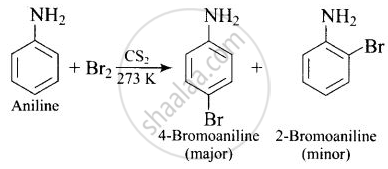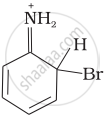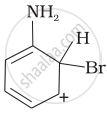Advertisements
Advertisements
Question
Predict the product of reaction of aniline with bromine in non-polar solvent such as \[\ce{CS2}\].
Solution

In non-polar solvent (such as \[\ce{CS2}\]) the activating effect of -NH2 group is reduced (due to resonance) and hence, mono substitution occurs only at o- and p-positions.
APPEARS IN
RELATED QUESTIONS
Arenium ion involved in the bromination of aniline is:
(i)

(ii)

(iii)

(iv)

Why does acetylation of –NH2 group of aniline reduce its activating effect?
How will you carry out the following conversions?
toluene `->` p-toluidine
A colourless substance ‘A’ \[\ce{(C6H7N)}\] is sparingly soluble in water and gives a water soluble compound ‘B’ on treating with mineral acid. On reacting with \[\ce{CHCl3}\] and alcoholic potash ‘A’ produces an obnoxious smell due to the formation of compound ‘C’. Reaction of ‘A’ with benzenesulphonyl chloride gives compound ‘D’ which is soluble in alkali. With \[\ce{NaNO2}\] and \[\ce{HCl}\], ‘A’ forms compound ‘E’ which reacts with phenol in alkaline medium to give an orange dye ‘F’. Identify compounds ‘A’ to ‘F’.
In order to distinguish between C2H5NHz and C6H5NHz, which of the following reagents is useful?
Which of the following is the most stable diazonium salt?
Benzene diazonium chloride is a ______.

Major Product In the above chemical reaction, intermediate "X" and reagent/condition "A" are:
Identify A and B for the following reaction:

What are polymers?
How will the following be converted? (Give chemical equation)
Aniline to benzene diazonium chloride.
